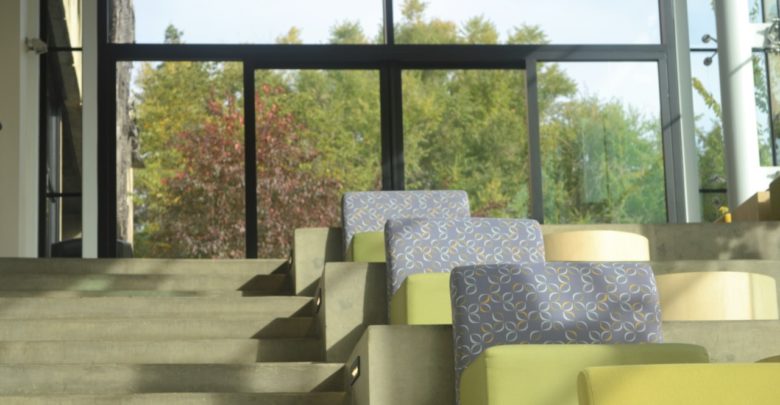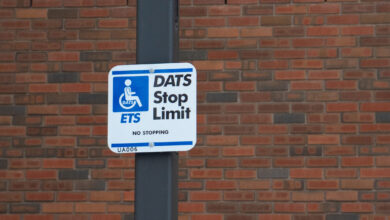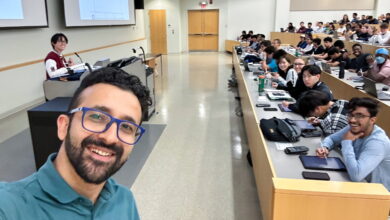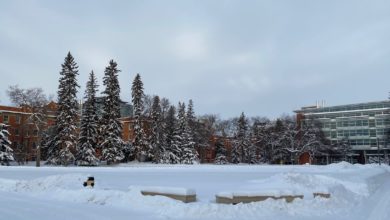New project launched to improve accessibility at the University of Alberta
“Think [about] how we can make campus [and] society at large more accessible [and] more inclusive, because it will benefit us all in the long run," graduate student says.
 Arthur Macatangay
Arthur MacatangayWhen Hussain Alaeddin Alhussainy, a University of Alberta political science master’s student, enters a building on campus, he said he is often met with barriers that other students don’t notice — elevators that close too quickly, automatic doors that don’t work, and construction zones that block pathways. As someone who uses a walker and a wheelchair, those obstacles are more than just inconveniences. It dictates how, and if, he can navigate the U of A campus.
Accessibility at the U of A is an ongoing challenge, but in an effort to increase accessibility, the Office of the Dean of Students (DoS) is conducting the Accessibility Enhancement project. The project is led by Ravina Sanghera, vice-provost and DoS, with support from Carrie Smith, vice-provost (access, community and belonging) (ACB), and the Office of the Deputy Provost (Students and Enrolment).
According to Smith, the Accessibility Enhancement project aims to improve “accommodations to achieve greater accessibility, and therefore access for all.”
The Accessibility Enhancement project has also recently been used as a pilot project in the ongoing creation of the Disability Cultures and Access Hub. The hub “serves as a centralized resource to co-ordinate tools, strategies, and awareness programs aimed at reducing barriers and supporting disability-inclusive practices.”
The hub is also meant to “centre disabled voices through the Council [For] Disability Cultures and Access, formally known as the Council on Systemic Ableism,” Smith said. It is set to be launched in “late winter 2025.”
“It’s been really exciting to see … how we might be able to take the learnings of the Accessibility Enhancement project to apply to other kinds of projects, to increase accessibility and access across campus,” Smith said.
“It’s a very promising initiative but we think it can go further,” Glock says
U of A Students’ Union (UASU) President Lisa Glock said the UASU hopes “that the university can push the [Council For Disability Cultures and Access] further than it has, [so] that they can focus more on action and analysis and increase its functionality when it comes to U of A policies and practices.”
“It’s a very promising initiative but we think it can go further,” she said.
Despite projects like the Accessibility Enhancement project, many U of A students struggle with accessibility. Alhussainy, who sits on the Council For Disability Cultures and Access, said that “infrastructure comes to mind immediately” in terms of the lack of accessibility at the U of A.
Automatic door-opener buttons, faulty or out-of-service elevators, and construction equipment scattered across the floor are only a few of the accessibility issues faced by U of A students with physical disabilities.
“As someone who uses a walker and a wheelchair, how do you navigate across these kinds of spaces?” Alhussainy asked.
According to Alhussainy, even the recently opened University Commons has accessibility issues, including elevator doors closing too fast.
“It was quite shocking. I think it’s the most accessible building on campus, but there are still major safety oversights that I think the university has overlooked,” Alhussainy said.
Priority areas for the Accessibility Enhancement project were “co-created with those with lived experience,” Sanghera says
The Accessibility Enhancement project has five priority areas — student experience, efficiency, relationships, communication, and optimization. According to Sanghera, these priority areas were “co-created with those with lived experience.”
“We have done extensive community consultations, culminating in evidence-based recommendations for accommodation services that focus on process and technology improvements. The top priorities were also identified with confirmation from the Council [For Disability Cultures and Access] as well,” Sanghera said.
Glock said that “we really have to listen to our constituents who do have these experiences and push for the things that they tell us are important.”
“There are systemic issues that, despite best efforts, have persisted,” Alhussainy says
On January 1, the U of A’s equity, diversity, and inclusion (EDI) office was renamed to ACB. Smith said that the transition “to talk[ing] about achieving our goals as ACB has been a work in progress for some time.”
“Access … is about fairness. And because of that, we need to engage in robust conversations so that people can meaningfully and equitably engage with a space, a program, a community, a learning environment, [or] an exam, in order to achieve their best,” Smith said.
According to Smith, “if we are striving to achieve access … and along the way we learn more and more about the barriers that are in place, the better off everyone is.”
Alhussainy said that “the university has a culture of EDI, but unfortunately fails on practical implementations and follow[ing] through on making sure accessibility is actually being granted.”
“There are systemic issues that, despite best efforts, have persisted. I think that the university does a good job at reaching [out to students] but not following through on their promises for accessibility and full inclusion,” he said.
Alhussainy said that it took three and a half years to receive the accommodations that he needed during his undergraduate studies. “The only reason I got to where I was able to get without these accommodations [was] because I had very sympathetic and understanding professors who really went above and beyond,” he explained.
“I have an issue with the systemic barriers on a university level, but I’m very appreciative of the people and the relationships I’ve built with my professors on the departmental level. Where the university fell short, they’ve picked up the pieces and made sure I was fully accommodated within the classroom,” Alhussainy added.
“We’re seeing more and more students requiring accommodations,” Sanghera says
In terms of challenges to accessibility, “having the human and budgetary resources to fund the enhancements is definitely a barrier,” according to Sanghera.
“We know some of the current trends where we’re seeing more and more students requiring accommodations, but the needs are multifaceted and sometimes complex. We’re going to need more resources,” Sanghera said.
Another issue is addressing accessibility and discussing disabilities in scholarly settings. Alhussainy said that the culture on campus is exclusionary to speaking about disabilities, even from an academic perspective. According to Alhussainy, most discussions surrounding disabilities are from a scientific perspective regarding how to cure the disability.
“We’re so focused on the cure that we [do not] fully includ[e] disabled people in the moment and accept them for who they are as individuals,” he said.
“We need to create a space for students with a disability,” Alhussainy says
In terms of disabled student voices being heard, Alhussainy said that the U of A does not have a space for disabled people to advocate and bring forward policy recommendations.
“We need to create a space for students with a disability, whether it is visible or non-visible, to say ‘hey, my needs aren’t being met,’” he said.
However, Alhussainy acknowledged that some people with disabilities prefer not to disclose that they have disabilities to avoid discrimination or stigma.
“I think a way we can improve that is simply by creating a culture of awareness [and] inclusion, so that individuals feel empowered [to speak up],” he said.
To increase accessibility at the U of A, Alhussainy noted three key areas of improvement — education, infrastructure, and the accommodations system.
Education needs to be adjusted through educating students and changing the culture on campus, he explained. He added that infrastructure can be improved through renovations that increase accessibility, not just “cosmetic design.” Lastly, he said the accommodations system needs to be improved so that students can lead their own accommodations processes.
“We know what we need to succeed and all requests should be honoured and respected.”
“I’m really reassured and excited that we’re on this path,” Sanghera says
One significant aspect of the Accessibility Enhancement project is the launch of a new student accommodations platform, Accommodate. This system will replace the current software, ClockWork.
Sanghera said the current processes “are creating challenges and that results in patchwork solutions that promote inconsistency, inequity, and confusion among students who need the services.”
Accommodate was chosen to replace ClockWork following listening tours and consultations with students, instructors, and staff, according to Sanghera.
“It was quite apparent that we need to modernize our software, because the software was serving as a barrier for instructors, students, and staff in terms of administering accommodations,” Sanghera said.
U of A instructors and students are currently in the process of helping to service design and test Accommodate. The platform will be piloted in summer 2025 and is planned to launch on a larger scale in fall 2025.
“To see the full impact of this project … is going to take time, and it’s going to be an iterative process. But I’m really reassured and excited that we’re on this path,” Sanghera said.
UASU executives work on accessibility concerns
The UASU has also worked towards increasing accessibility at the U of A in the form of the UAlberta Accessibility Map. The map was co-created by the Vice-president (academic) Layla Alhussainy and the Office of the DoS.
“This will allow for easier route planning for students dealing with accessibility needs,” Glock said.
Week of Welcome (WoW) in September 2024 is another example of recent accessibility enhancements. Glock said she worked with the DoS Office, ACB Office, and Campus Services “to bring in solid flooring for the first time to WoW,” Glock said.
“Bringing in elements like that, whether that’s stable flooring, a ramp when we have staged events — those are all really important to consider,” she said.
Vice-president (external) Abdul Abbasi has also been advocating for increased funding to Campus Saint-Jean (CSJ), according to Glock. “Hopefully that will help with some of the language barrier accessibility concerns,” she said.
Accessibility is “such a wide-ranging issue that a lot of the work being put in crosses a lot of portfolios,” according to Glock.
Additionally, Glock said that she has established a coalition with the Non-Academic Staff Association (NASA), the Graduate Students’ Association (GSA), and the Postdoctoral Fellows Association (PDFA).
“The ability to work with our partners and to continue consulting with our partners, and the willingness [and] drive to constantly bring those issues to the university, is something that will continue,” Glock said.
Another accessibility improvement that the UASU has made is the move to decentralize alcohol from their events, such as the UASU awards night.
“We think it’s an accessibility in the mental health realm, so we’ve been trying to pursue it from that angle as well,” Glock said.
Alhussainy encourages U of A community to think about how to make campus “accessible for all”
Despite this, not all UASU events are accessible. One UASU event held every year is the Imaginus poster sale. The poster sale is held on the large staircase on the south side of the Students’ Union Building (SUB).
Alhussainy said that, as someone who cannot navigate stairs, the only posters he is able to see are the ones at the top of the stairs and the ones at the bottom of the stairs, which he has to take an elevator to get down to.
“How is someone like me supposed to properly engage with opportunities on campus? How are disabled [people] supposed to engage with opportunities on campus if accessibility isn’t in mind?”
According to Alhussainy, “if disabled people aren’t included in the conversation and in the planning process, no one seems to actually plan for accessibility,” although he said this is not usually with malicious intent.
Alhussainy encouraged the U of A community to be “proactive” in making sure that society and the U of A campus is “accessible for all.”
“Think [about] how we can make campus [and] society at large more accessible [and] more inclusive, because it will benefit us all in the long run.”




